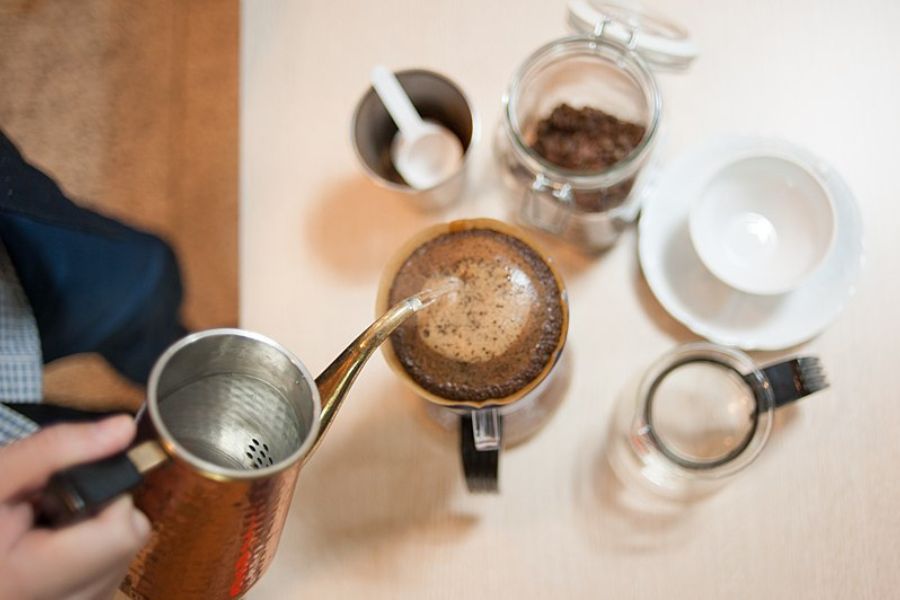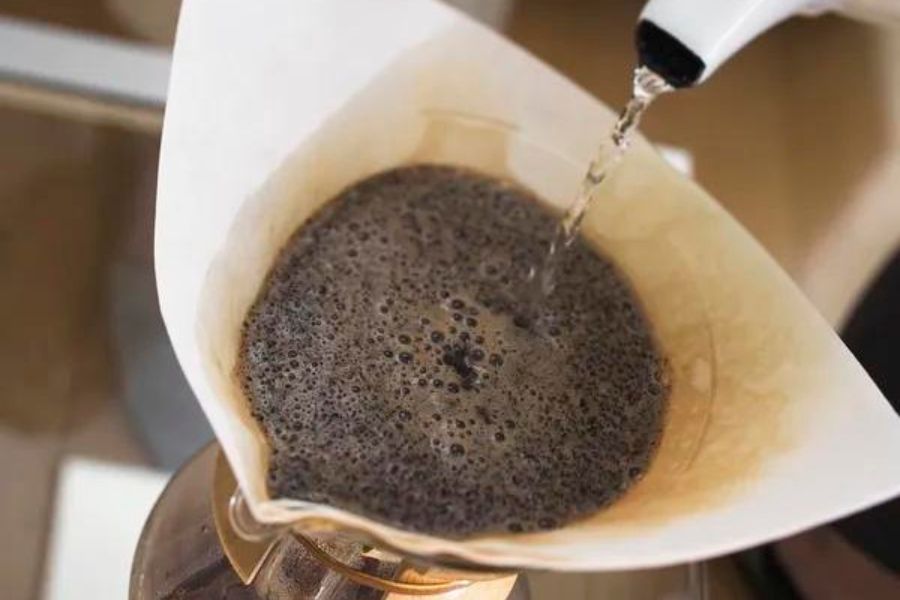What Is Coffee Bloom?
What is coffee bloom? Maybe you haven’t heard of that term, but if you drink pour-over, French press, or even automatic drip coffee, it’s a vital part of the java-brewing process.
Simply put, the bloom means pouring hot water over your freshly ground coffee, just enough to soak your grinds, but not enough to flood them. Let the grinds soak in water for 30-90 seconds — depending on your brew method — and you’ll see the magic of the bloom in action.
You’ll notice the grinds swell up, and bubbles will rise to the surface. It resembles a flower blooming — hence, its name. Some fully automatic brew machines may have a pre-infusion setting that does it for you, but if you’re making your own pour-over, French press, or even drip coffee, don’t skip this step!
So what’s the big deal about blooming? These are some topics we’ll cover:
What Is a Coffee Bloom?
You may have seen its process, but most java lovers aren’t familiar with the term “coffee bloom.” This is a name for the bubbling up that occurs when hot water comes into contact with freshly ground coffee. The grinds plump up and appear to form bubbles. This happens because of a rapid chemical reaction that results in carbon dioxide being released quickly from coffee.

Causes of Coffee Blooming
So what causes coffee bloom? Obviously, the short answer is that carbon dioxide, or CO2, is released, and you see bubbles form as a result. But there’s more to it than that.
During the roasting process, heat traps carbon dioxide inside coffee beans. After roasting, beans start releasing that CO2 slowly — a process known as degassing. This is why you may see a valve on the packaging of your beans or coffee canister in which they’re stored. The valve allows carbon dioxide to flow out of the container or package.
When coffee beans are ground, you increase the surface area of the coffee, which causes it to degas at a faster rate. This is part of the reason why ground coffee goes stale quicker than whole beans. Water accelerates this process, so when you pour hot water over freshly ground coffee, you can physically see degassing in action.
Why Coffee Bloom Matters
What is the purpose of blooming coffee? There are a few reasons why it matters:
- When carbon dioxide is present in brewed java, it gives it a sour taste. Hence, if you don’t let the coffee bloom to get rid of that CO2, your brewed beverage will have that acidic flavor, ruining your cup of joe.
- During the brewing process, water attracts aromatics and oils from coffee — giving it such a great flavor. However, CO2 repels water, which disrupts that process, again, ruining your morning beverage.
- When coffee is properly bloomed, water can rest on top of the grounds and work its way slowly and evenly through the grounds. This means extraction happens more evenly, which enhances your brew’s flavor.
- What if no bloom occurs when you pour that hot water over freshly ground coffee? Unfortunately, it’s a clear indicator that your coffee is stale. So, it’s time to throw it out and buy new.
Variables That Affect Bloom Coffee
All coffee blooms are not created equal — in that, many factors can affect this java-brewing chemical reaction:
- Temperature — coffee beans are very finicky about temperature. Beans stored in hot conditions will degas more rapidly. In contrast, coffee beans kept in the cold release less carbon dioxide. The ideal temperature for storing coffee is cool, but not cold.
- Humidity — keeping coffee in a very dry environment will cause coffee beans to degas more quickly, as a result, the bloom will be lower. However, too much humidity can lead to fungus and mold forming on your coffee beans.
- Roast level — dark roasts typically degas faster than lighter roasts. This is likely due to cracks that form as part of the roasting process, allowing carbon dioxide to escape more easily. With less CO2 present, this coffee will not bloom as much.
- Bean hardness — this one is quite logical, it’s more difficult for gases to escape from coffee beans that are harder and more dense. So coffee ground from hard beans may bloom more.
- Coffee origin — where your beans came from may determine the extent of the bloom. Just as some regions produce coffee with particular flavors, some regions produce coffee that blooms more, or less.

How to Bloom Coffee
Blooming coffee isn’t necessary for all forms of brewing, but for a few select methods, it’s an important step that shouldn’t be overlooked. It’s commonly used with pour-over, French press, and automatic drip coffee. Cold brew can also benefit from blooming, and blooming by another name — pre-infusion — is used with espresso.
Knowing how long to bloom coffee is important. The water should also be at brewing temperature. Please note that you cannot bloom pre-ground coffee. This has already degassed, so there’s no carbon dioxide left to escape.
Pour-over
- Start from the outside, use a circular motion and slowly pour hot water onto the coffee grinds while moving inward.
- Soak the grinds, but not so much that water drips through.
- After soaking your grinds, let the coffee bloom for 30-45 seconds.
- Continue brewing.
French Press
- Add coffee grinds to the filter.
- Pour a small amount of hot water over them.
- Let it bloom for about 20-30 seconds.
- Stir gently with a spoon before brewing.
Automatic Drip Coffee
- Put ground coffee in the filter.
- Wet the grounds with hot water — grounds should be completely wet, but not dripping.
- Let them bloom for 45-60 seconds.
- Brew as you normally do.
Cold Brew
- Place ground coffee into your container.
- Add enough hot water to wet the grinds.
- Let it bloom for about 30-45 seconds.
- Add room temperature or cold water.
- Brew for 12-24 hours in your fridge.
Espresso
As stated earlier, the bloom in espresso is known as pre-infusion. It doesn’t look like a typical bloom, because grinds are tamped down in a portafilter. Hence, if you have an automatic espresso machine, it likely has a pre-infusion setting built into its brew cycle.
For a manual espresso maker, do a very short pull to add enough water to wet the grinds. Let it rest for about 30 seconds, then pull your shot of espresso.

Recapping
Coffee bloom is the term that describes a chemical reaction when very hot water comes in contact with freshly ground coffee. It brings about a dramatic release of carbon dioxide, which causes coffee grinds to swell and bubble up.
Carbon dioxide forms inside coffee beans during roasting, and beans naturally degas afterward. That process is sped up when the beans are ground, and coffee bloom is the result. What happens if you don’t bloom before brewing? Your java may taste sour and won’t brew properly.
Blooming is most commonly used with pour-over and French press java, but certainly won’t harm your beverage if it’s used with any other brewing methods. Giving those coffee grinds a quick soak will enhance the flavors. What is coffee bloom? It’s a step you can’t afford to skip!
What Is Blooming Coffee? FAQs
What Happens if You Don’t Bloom Coffee?
With pre-ground coffee, blooming isn’t necessary. However, if you don’t bloom freshly ground coffee, all of the carbon dioxide may not be released before brewing. CO2 will give your brew an unpleasant sour flavor.
How Long Do You Bloom Pour Over Coffee?
You should let your coffee bloom for about 30-45 seconds when using the pour-over method for brewing.
What Is Blooming in Coffee?
Coffee blooming means that coffee is releasing carbon dioxide very quickly. The grinds swell up, and you can even see bubbles forming when hot water first comes in contact with freshly ground coffee.
How Do You Bloom Espresso?
If you’re using an automatic espresso machine, it likely has a pre-infusion step that’s part of its brewing cycle. This is the equivalent of blooming coffee. With a manual espresso maker, you can pull just enough water to wet the grinds in a portafilter. Let it sit for about 30 seconds, and then pull your espresso shot as normal.
How Do You Know if Coffee is Blooming?
Oh, you’ll know! You’ll be able to see your coffee grounds bubble up as hot water hits them. It’s a very quick process. Pre-ground coffee will not bloom because it’s already released all of its carbon dioxide. However, if your freshly ground coffee doesn’t bloom, it’s probably stale.
Why Bloom Coffee in a French Press?
It’s important to bloom coffee in a French press to ensure that all the carbon dioxide has been released from the coffee beans before you start brewing.





